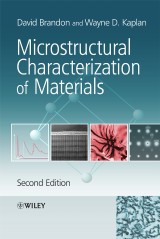Details

Microstructural Characterization of Materials
2. Aufl.
|
56,99 € |
|
| Verlag: | Wiley |
| Format: | EPUB |
| Veröffentl.: | 21.03.2013 |
| ISBN/EAN: | 9781118681480 |
| Sprache: | englisch |
| Anzahl Seiten: | 560 |
DRM-geschütztes eBook, Sie benötigen z.B. Adobe Digital Editions und eine Adobe ID zum Lesen.
Beschreibungen
Microstructural characterization is usually achieved by allowing some form of probe to interact with a carefully prepared specimen. The most commonly used probes are visible light, X-ray radiation, a high-energy electron beam, or a sharp, flexible needle. These four types of probe form the basis for optical microscopy, X-ray diffraction, electron microscopy, and scanning probe microscopy.<br /> <br /> <i>Microstructural Characterization of Materials, 2nd Edition</i> is an introduction to the expertise involved in assessing the microstructure of engineering materials and to the experimental methods used for this purpose. Similar to the first edition, this 2nd edition explores the methodology of materials characterization under the three headings of crystal structure, microstructural morphology, and microanalysis. The principal methods of characterization, including diffraction analysis, optical microscopy, electron microscopy, and chemical microanalytical techniques are treated both qualitatively and quantitatively. An additional chapter has been added to the new edition to cover surface probe microscopy, and there are new sections on digital image recording and analysis, orientation imaging microscopy, focused ion-beam instruments, atom-probe microscopy, and 3-D image reconstruction. As well as being fully updated, this second edition also includes revised and expanded examples and exercises, with a solutions manual available at http://develop.wiley.co.uk/microstructural2e/ <br /> <br /> <i>Microstructural Characterization of Materials, 2nd Edition</i> will appeal to senior undergraduate and graduate students of material science, materials engineering, and materials chemistry, as well as to qualified engineers and more advanced researchers, who will find the book a useful and comprehensive general reference source.
Preface to the Second Edition. <p>Preface to the First Edition.</p> <p><b>1. The Concept of Microstructure.</b></p> <p>1.1. Microstructural Features.</p> <p>1.2. Crystallography and Crystal Structure.</p> <p><b>2. Diffraction Analysis of Crystal Structure.</b></p> <p>2.1. Scattering of Radiation by Crystals.</p> <p>2.2. Reciprocal Space.</p> <p>2.3. X-ray Diffraction Methods.</p> <p>2.4. Diffraction Analysis.</p> <p>2.5. Electron Diffraction.</p> <p><b>3. Optical Microscopy.</b></p> <p>3.1. Geometrical Optics.</p> <p>3.2. Construction of the Microscope.</p> <p>3.3. Specimen Preparation.</p> <p>3.4. Image contrast.</p> <p>3.5. Working with Digital Images.</p> <p>3.6. Resolution, contrast and Image Interpretation.</p> <p><b>4. Transmission Electron Microscopy.</b></p> <p>4.1. Basic Principles.</p> <p>4.2. Specimen Preparation.</p> <p>4.3. The Origin of Contrast.</p> <p>4.4. Kinematic Interpretation of Diffraction Contrast.</p> <p>4.5. Dynamic Diffraction and Absorption effects.</p> <p>4.6. Lattice Imaging at High Resolution.</p> <p>4.7. Scanning Transmission Electron Microscopy.</p> <p><b>5. Scanning Electron Microscopy.</b></p> <p>5.1. Components of The Scanning electron Microscope.</p> <p>5.2. Electron Beam-Specimen Interactions.</p> <p>5.3. Electron Excitation of X-Rays.</p> <p>5.4. Backscattered Electrons.</p> <p>5.5. Secondary Electron Emission.</p> <p>5.6. Alternative Imaging Modes.</p> <p>5.7. Specimen Preparation and Topology.</p> <p>5.8. Focused Ion Beam Microscopy.</p> <p><b>6. Microanalysis in Electron Microscopy.</b></p> <p>6.1. X-Ray Microanalysis.</p> <p>6.2. Electron Energy Loss Spectroscopy.</p> <p><b>7. Scanning Probe Microscopy and Related Techniques.</b></p> <p>7.1. Surface Forces and Surface Morphology.</p> <p>7.2. Scanning Probe Microscopes.</p> <p>7.3. Field-Ion Microscopy and Atom Probe tomography.</p> <p><b>8. Chemical Analysis of Surface Composition.</b></p> <p>8.1. X-ray Photoelectron Spectroscopy.</p> <p>8.2. Auger Electron Spectroscopy.</p> <p>8.3. Secondary-Ion Mass Spectrometry.</p> <p><b>9. Quantitative and Tomographic Analysis of Microstructure.</b></p> <p>9.1. Basic Stereological Concepts.</p> <p>9.2. Accessible and Inaccessible Parameters.</p> <p>9.3. Optimizing Accuracy.</p> <p>9.4. Automated Image Analysis.</p> <p>9.5. Tomography and Three-Dimensional Reconstruction.</p> <p>Appendices.</p> <p>Index.</p>
<p><b>David Brandon</b>, Israel Institute of Technology, Haifa, Israel, is the author of <i>Microstructural Characterization of Materials</i>, 2nd Edition, published by Wiley.</p> <p><b>Wayne D. Kaplan,</b> Israel Institute of Technology, Haifa, Israel, is the author of <i>Microstructural Characterization of Materials</i>, 2nd Edition, published by Wiley.</p>
<p>Microstructural characterization is usually achieved by allowing some form of probe to interact with a carefully prepared specimen. The most commonly used probes are visible light, X-ray radiation, a high-energy electron beam, or a sharp, flexible needle. These four types of probe form the basis for optical microscopy, X-ray diffraction, electron microscopy, and scanning probe microscopy.</p> <p>The book is an introduction to the expertise involved in assessing the microstructure of engineering materials and to the experimental methods used for this purpose. Similar to the first edition, this 2nd edition of Microstructural Characterization of Materials explores the methodology of materials characterization under the three headings of crystal structure, microstructural morphology, and microanalysis. The principal methods of characterization, including diffraction analysis, optical microscopy, electron microscopy, and chemical microanalytical techniques are treated both qualitatively and quantitatively. An additional chapter has been added to the new edition to cover surface probe microscopy, and there are new sections on digital image recording and analysis, orientation imaging microscopy, focused ion-beam instruments, atom-probe microscopy, and 3-D image reconstruction. As well as being fully updated, this second edition also includes revised and expanded examples and exercises.</p> <p>The book should appeal to senior undergraduate and graduate students of material science, materials engineering, and materials chemistry, as well as to qualified engineers and more advanced researchers, who should find the book a useful and comprehensive general reference source.</p>
Diese Produkte könnten Sie auch interessieren:

Chemistry for the Protection of the Environment 4

von: Robert Mournighan, Marzenna R. Dudzinska, John Barich, Marjorie A. Gonzalez, Robin K. Black

213,99 €















